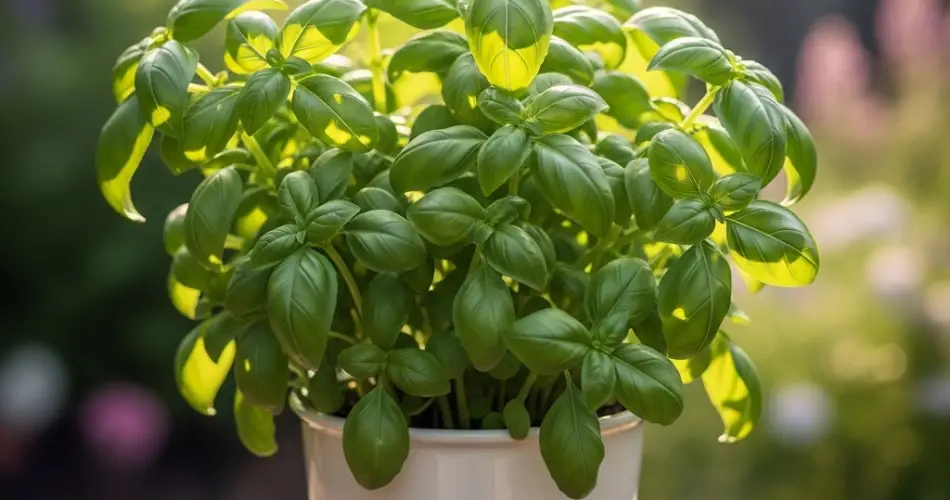Basil is one of the most beloved herbs in the kitchen—fresh, aromatic, and bursting with flavor. Whether added to pasta, pesto, or salads, it brings a vibrant touch to any dish. But did you know you can grow a healthy basil plant right from kitchen scraps? With minimal effort, even a small cutting from store-bought basil can transform into a thriving indoor herb garden.
If you love basil and want a sustainable, simple way to grow it at home, here’s how to do it—no green thumb required.
Why Grow Basil from Kitchen Scraps?
Growing basil from scraps is economical, eco-friendly, and surprisingly effective. Instead of throwing away leftover stems from store-bought bunches, you can use them to cultivate new plants. This method works especially well for those with limited space, making it perfect for apartments, balconies, or sunny windowsills.
Plus, there’s something deeply satisfying about giving food waste a second life and turning it into something useful—and delicious.
Selecting the Right Basil Cuttings
Start with a fresh bunch of basil—preferably organic, as it hasn’t been treated with growth inhibitors. Choose healthy stems that are at least 4–6 inches long and have no signs of disease, rot, or damage. The ideal cutting should have a few sets of leaves at the top and a clean, straight stem.
Preparing the Cuttings
-
Trim the Stems: Use clean scissors or a knife to cut the stems just below a leaf node (where leaves attach to the stem). Nodes are where new roots will form.
-
Remove Lower Leaves: Strip away the lower leaves, leaving only the top two or three sets. This helps the plant direct energy to root development rather than leaf maintenance.
-
Place in Water: Fill a small glass or jar with room-temperature water and place the cuttings inside, ensuring the leafless part of the stem is submerged. Avoid letting any leaves touch the water, as they may rot.
Rooting Basil in Water
Position the jar in a bright area with indirect sunlight, such as a kitchen windowsill. Direct sunlight can be too harsh at this stage and may dry out or stress the cuttings.
Change the water every 2–3 days to keep it fresh and oxygenated. Within 5 to 10 days, you’ll notice tiny white roots emerging from the nodes. After two weeks, most cuttings will have a solid root system about 2 inches long—enough to transfer to soil.
Planting Your Basil Cuttings
Once the roots are established, it’s time to give your basil a permanent home in soil.
-
Choose the Right Pot: Use a small pot (4–6 inches) with good drainage holes. Basil does well in containers and adapts easily to indoor environments.
-
Use Quality Soil: A light, nutrient-rich potting mix with good drainage is ideal. You can mix in compost or perlite to enhance aeration and fertility.
-
Plant Carefully: Make a small hole in the soil, place the rooted cutting inside, and gently press the soil around the stem. Water lightly but thoroughly after planting.
-
Provide Light: Place your basil pot in a sunny spot where it can receive 6–8 hours of indirect or filtered sunlight daily. A south-facing window is ideal. If natural light is limited, consider using a small grow light.
Daily Care Tips
-
Watering: Basil prefers consistently moist (not soggy) soil. Water when the top inch of soil feels dry. Overwatering can lead to root rot, while underwatering can cause wilting.
-
Humidity: Indoor environments can be dry, especially in winter. Mist the leaves occasionally or place the pot on a tray with pebbles and water to increase humidity.
-
Fertilizing: Every 3–4 weeks, feed basil with a mild, organic liquid fertilizer diluted to half strength. This encourages leaf production and overall plant health.
Pruning for Better Growth
Pruning is essential for basil. Once the plant reaches about 6 inches tall, pinch off the top pair of leaves above a node. This will stimulate the plant to grow sideways and produce more leaves.
Continue to pinch off new flowering shoots as they appear. Flowering signals the end of the basil’s life cycle, and preventing it will keep your plant in a productive, leafy state longer.
Harvesting Your Basil
Begin harvesting once the plant has enough leaves to sustain growth. Always pick from the top rather than the bottom, and take full stems rather than individual leaves. This encourages healthy, bushy growth and helps prevent legginess.
Use freshly harvested basil immediately in your recipes, or preserve it by freezing in olive oil or making pesto.
Final Thoughts
Growing basil from kitchen scraps is a surprisingly simple and gratifying experience. With just a glass of water, some sunlight, and a bit of attention, you can transform leftover stems into a lush, aromatic herb that enhances both your cooking and your living space. Whether you’re a beginner or a seasoned gardener, nurturing basil indoors offers a practical and sustainable way to enjoy fresh herbs year-round—right from your windowsill.



